It’s PFF QB Annual season, a culmination of the very best quarterback breakdowns from the depths of the PFF database. The annual features a regular-season recap of 36 quarterbacks, all featured here, and we’ve added one key stat per signal-caller that is found within the guide. The quarterbacks are ranked by their current PFF grade through the first three weeks of the playoffs, and of course, the PFF grading system isolates the play of each quarterback on every play during the season. Here’s a look at the top quarterbacks in the NFL in 2019 as ordered by PFF grade.
[Editor's Note: All EDGE and ELITE subscribers can download the 2020 QB Annual here. All non-subscribers can sign up for an annual subscription for 30% off using promo code PFF30.]

1. Russell Wilson, Seattle Seahawks
The highest-graded passer with at least 300 attempts, Wilson had a spectacular season attacking down the field with his usual array of big-time throws while limiting turnover-worthy plays at the best rate of his career. As the season progressed, Wilson’s raw stats took a hit, but it was more due to what was happening around him rather than his throw-for-throw performance. He still takes too many sacks, including 14 that we directly charged his way, but Wilson is the catalyst to the Seattle offense, despite their desire to build a run-first attack. Throughout his career, Wilson has had many games in which he looked like a top-three quarterback but also a bevy of outings in which he was way off his game. In 2019, he posted the highest grade of his career, and for the first time, posted just one game grade that came in under 60.0.
Key Stat from QB Annual: Wilson finished with the No. 3 PFF grade from a clean pocket and he also ranked third under pressure.
2. Patrick Mahomes, Kansas City Chiefs
Mahomes battled injuries from the get-go as he fought through an ankle injury starting in Week 1 and eventually missed some time with a knee injury. While the Chiefs' offense is still one of the most explosive units in the league, Mahomes took a slight step back from his 2018 MVP campaign. As tantalizing as Mahomes’ highlight reel is, perhaps most impressive in 2018 was that he rarely missed throws. In 2019, though, he saw a four-percentage point increase in negatively graded throws. Part of the regression may be chalked up to injuries, but regardless, Mahomes' talent and the Chiefs' system make up a dangerous offense. He is still more than capable of taking over games and moving the ball down the field in a hurry.
Key Stat from QB Annual: Fifty-nine percent of Mahomes’ targeted attempts were considered “open,” seven percentage points higher than the league average.
3. Drew Brees, New Orleans Saints
A thumb injury cost Brees a chunk of the season, but he once again showed that he could spread the ball around accurately while consistently making good decisions. Brees earned his second straight 90.0-plus grade, avoiding negatives better than any other quarterback in the league. He did see a downtick in his big-time throws, and despite strong stats in the last two games of the season, he forced multiple passes down the field that should have been intercepted but didn’t show up on the stat sheet. That’s the big question moving forward, as Brees still has the ability to lead an offense with his quick decision making and accuracy, but the downfield passing game was inconsistent this season. As such, there are concerns about Brees’ age and if he’ll be limited in the next year or two.
Key Stat from QB Annual: Brees ranked just 29th in big-time throw percentage, but he was fifth-best at avoiding turnover-worthy plays.
4. Ryan Tannehill, Tennessee Titans
In one of the biggest breakout seasons in history, Tannehill became one of the league’s best passers, dominating at all levels of the field. He more than doubled his percentage of positively graded throws from a year ago, which is a ridiculous feat, even in small sample sizes. Tannehill was accurate to all levels of the field and was the league’s best on 10-plus yard throws. His career year led the Titans to the No. 2 passing attack in EPA from the time he took over as starter through the end of the season. While Tannehill had settled in as a mid-tier starter in his first five years in the league, he was the league’s lowest-graded starter in 2018 before posting the top grade in 2019, the biggest one-season increase in the PFF era. His 2019 campaign was special, and it's one that will be difficult to duplicate.
Key Stat from QB Annual: Tannehill finished with the highest PFF grade from a clean pocket during the regular season.
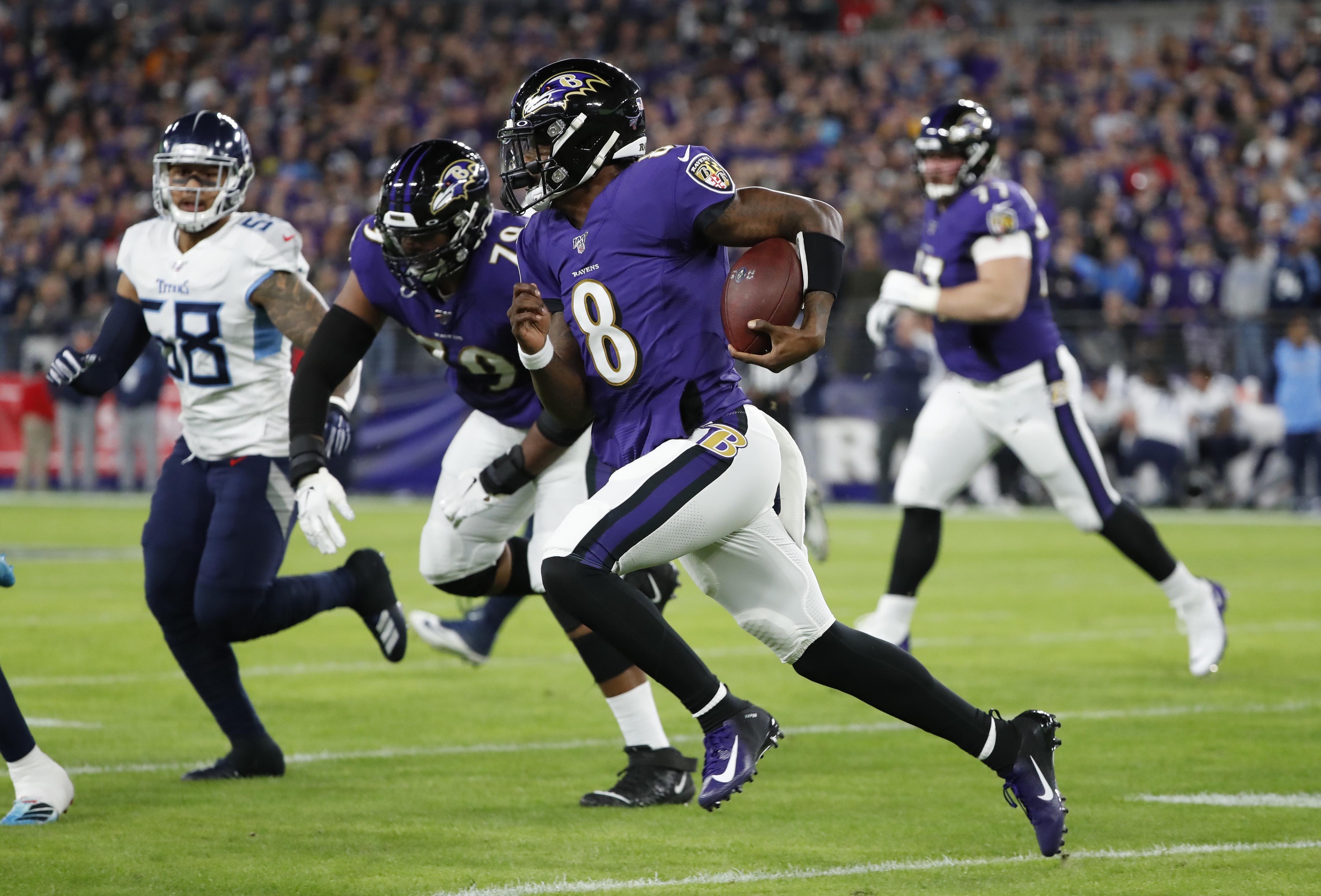
5. Lamar Jackson, Baltimore Ravens
Outside of Tannehill, Jackson made the league's biggest stride as a passer, as he improved from a second-to-last ranking in catchable pass rate to 15th. The Ravens have built a perfect system to take advantage of Jackson’s unique skill set, and he subsequently led the league with 776 yards on designed runs and another 430 on scrambles. But it was Jackson’s improvement as a passer that turned the offense into the league’s best during the regular season. The threat Jackson presents as a runner creates better pass-blocking situations while also putting defenders’ heads on a swivel when trying to find the ball in the designed run game. It all adds up to an efficient run game and more open throws in the passing game. Jackson also cut down on his turnover-worthy plays, which is even more impressive given how often he handles the ball.
Key Stat from QB Annual: Jackson worked to his “next” read (second side of the field) 18% of the time, five percentage points higher than the league average. His 0.025 EPA per play was well above the league average of -0.06.
6. Kirk Cousins, Minnesota Vikings
After a slow start to the season and one of the worst games of his career in Week 2 against the Packers, Cousins turned things around to put together the best performance of his career and his second top-10 finish in PFF grading. He took to the Vikings’ outside zone/play action-heavy scheme, working well both inside and outside the pocket. Cousins was incredibly accurate at the intermediate (10 to 19 yards downfield) level, and he cut down on his turnover-worthy plays. The biggest improvement this season was his increase of 3.8 percentage points in positively graded throw rate, the third-highest mark in the NFL, and that's a credit to the system and supporting cast in Minnesota, even with their injury woes. Overall, it was a strong second season for Cousins, who improved his game and came through in big spots over the course of the year.
Key Stat from QB Annual: Cousins finished with the No. 4 PFF grade from a clean pocket, but he ranked just 23rd under pressure.
7. Aaron Rodgers, Green Bay Packers
One of the biggest offseason questions centered around Rodgers playing in a new system, and even with a 13-3 record and first-round bye, Rodgers didn’t exactly answer those questions with flying colors. He finished with a solid grade but also had multiple poor games, and he even produced the lowest-graded outing of his career in Week 12. There’s no denying Rodgers’ talent — and he’s still one of the league’s best at hitting big-time throws and avoiding turnover-worthy plays — but the thing that has made Rodgers one of the best quarterbacks of all time is his ability to hit the “easy” throws and avoid negative plays. Those elements of his game have taken a step back in recent years, and that trend has now stretched across multiple systems. Perhaps Rodgers can get back to his top-three self, but he’ll have to improve his short and intermediate accuracy while cutting down on the pressure that he’s invited in recent years.
Key Stat from QB Annual: Rodgers had the 18th-best PFF grade from a clean pocket, but he ranked sixth when under pressure.
8. Matthew Stafford, Detroit Lions
In one of the biggest single-year transformations in recent memory, Stafford briefly returned to his best in 2019 before he lost his season due to injury. Stafford increased his average depth of target by over four yards per attempt, a massive improvement in offensive aggressiveness that led to the most efficient year of his career and the league’s highest percentage of big-time throws. He also saw the biggest jump in the percentage of positively graded throws outside of Ryan Tannehill, which led to the league’s sixth-most efficient passing attack while Stafford was on the field. He had fallen into more of a game manager mode in recent seasons, but Stafford and the Lions embraced a high-risk, high-reward style that led to more explosive plays but also a few more misses down the field. And if they continue down that path, the payout could be massive.
Key Stat from QB Annual: Twenty-seven percent of Stafford’s targets were into tight windows, eight percentage points higher than the league average.
9. Deshaun Watson, Houston Texans
Watson continues to light up the highlight reels, but the week-to-week consistency still needs work. For the second straight year, Watson had six games that earned an 80.0-plus grade, and those are the games in which he looks like an MVP candidate capable of carrying a team. However, he also had three games that graded under 50.0, and those games usually involve poor ball security and taking too many sacks. Watson ranked among the league’s best in big-time throws once again, but in order to take the next step as a true MVP candidate, he must cut down on the faults that have plagued him to low game grades in the past. It’s a difficult balance, as Watson’s high-risk, high-reward style pays off more often than not, but it’s still leading to too many games in which his poor play is too much for Houston to overcome.
Key Stat from QB Annual: Watson averaged 0.17 EPA per play on scramble-drill passes, well above the league average of 0.02.
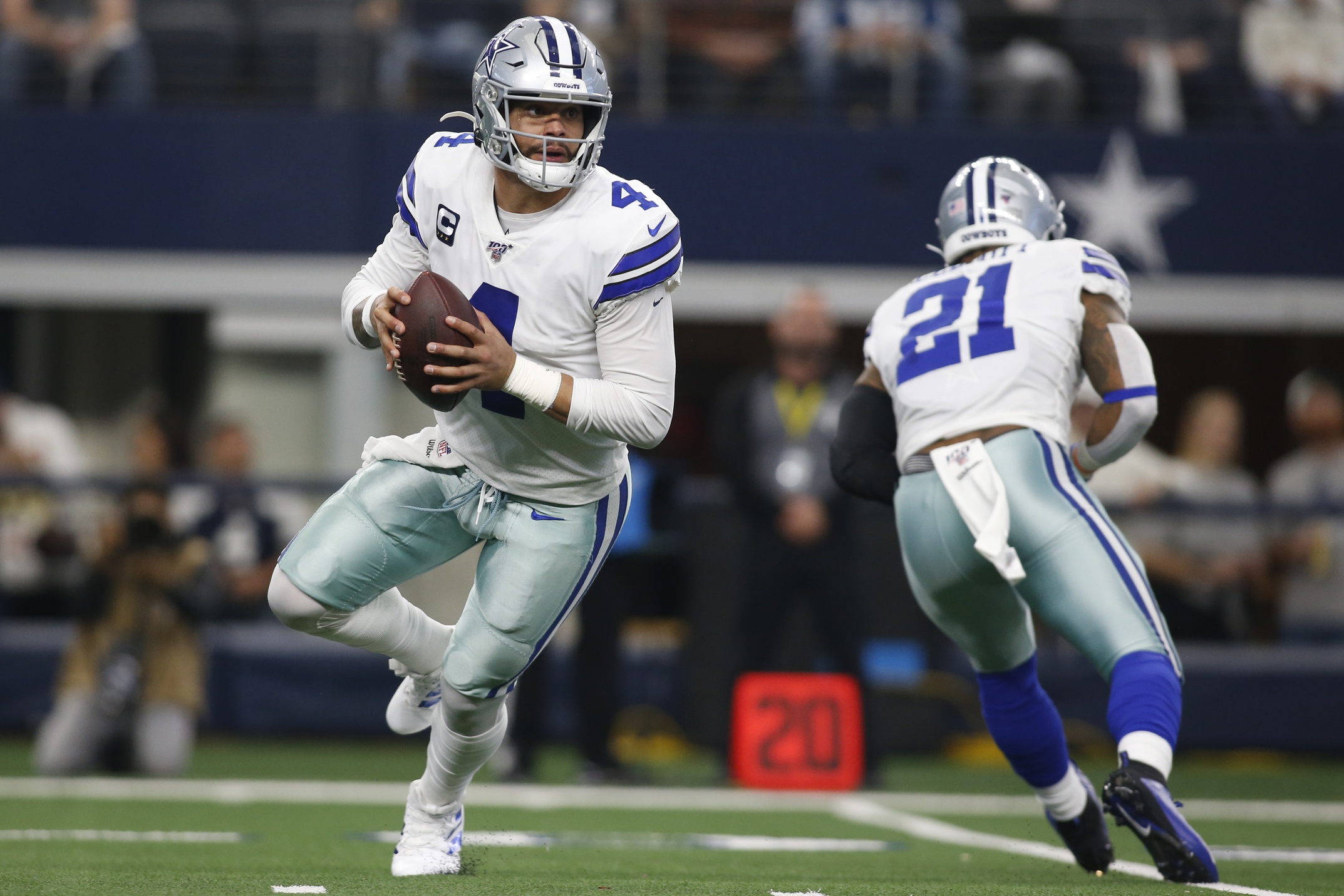
10. Dak Prescott, Dallas Cowboys
Prescott had his most productive season since his rookie year, as fresh play-calling and a full year of strong playmakers led to Dallas ranking third in the league with an EPA of 0.23 on passing plays. Prescott ranked among the middle class of quarterbacks in PFF grading in 2017 and 2018, and his 2019 campaign showed that the right supporting cast could lead to high-end production from mid-tier signal-callers. Prescott attacked down the field more than ever, leading to his No. 3 ranking in the league in passing yards on 20-plus yard throws, and he finished fourth in PFF rushing grade at 76.2. Overall, it was a good season for Prescott, who improved his positively graded throws, cut down on the negatives and showed that he could have a top-notch season when given a strong group of receivers.
Key Stat from QB Annual: Prescott averaged 0.26 EPA per dropback on “first read” throws, well above the league average of 0.07.
11. Derek Carr, Oakland Raiders
It was a good season for Carr, who finished with the second-best PFF grade of his career. He ranked among the league’s best in accuracy and avoiding negatives while also doing a fine job of taking care of the ball despite a group of pass-catchers that was one of the biggest question marks in the league. Carr is more than capable of attacking down the field, but whether it’s the system, lack of playmakers or simply a conservative nature, Carr finished with the third-lowest average depth of target in the league (6.9). Even in games that saw the Raiders fall behind early, Carr rarely pushed the ball down the field. He has the velocity, touch and accuracy to create big plays, but Carr has profiled as more of a game manager in recent years. Perhaps an influx of playmakers can unlock the potential that he flashed in his highest-graded season in 2016.
Key Stat from QB Annual: Carr had the second-lowest percentage of negatively graded throws, but he finished just 27th in big-time throw percentage.
12. Tom Brady, New England Patriots
After playing perhaps the best football of his career from 2014-17, Brady took a slight step back in performance in 2018 and yet another step back in 2019. This season coincided with his worst group of playmakers in years, and the result was an uncharacteristically mediocre statistical performance for Brady. Heading into his age 43 season, Brady is less likely to be able to carry an offense as he has in the past, as we’ve seen an uptick in his negatively graded throws and turnover-worthy plays over the past two years. Last season, we saw a downtick in Brady’s play under pressure and his outside-of-structure plays, but he is still capable of moving the chains with his signature good decision-making and accuracy — it’s just a matter of creating more opportunities with a versatile group of playmakers.
Key Stat from QB Annual: Brady ranked just 23rd in big-time throw percentage, but he finished eighth at avoiding turnover-worthy plays.
13. Jimmy Garoppolo, San Francisco 49ers
We finally got to see a full season of play from Garoppolo, who performed well in San Francisco’s offensive system. Much like his run in 2017, he had a high percentage of positively graded throws and a low percentage of negatives, but he ranked near the bottom in big-time throws. Garoppolo also saw an uptick in turnover-worthy plays, as he made several poor decisions over the middle of the field to go with some ball security issues in the pocket. Overall, Garoppolo was one of the league’s most accurate passers, and his quick release and decision-making have proven to be a good fit in the Shanahan system. He is yet another mid-tier quarterback who can produce at a top-10 level in any given season, especially if he can cut back on the random poor decisions that seem to pop up once or twice in every game.
Key Stat from QB Annual: Garoppolo ranked just 31st in big-time throw percentage, but he finished fifth in percentage of on-target throws.
14. Ryan Fitzpatrick, Miami Dolphins
Given his supporting cast, Fitzpatrick had one of the most impressive seasons of any quarterback this year. He elevated Miami's offense despite facing the fourth-highest pressure rate, and his downfield aggressiveness led to the Dolphins turning into a pesky, competitive team down the stretch. This is now the best two-year stretch of Fitzpatrick’s career, as he finished as a borderline top-10 quarterback for the Buccaneers in 2018 and he ranked in the top 15 in 2019. It’s also the second straight year that Fitzpatrick ranked among the league's leaders in positively graded throws, showing that he can put his playmakers in position to make plays. He has an intriguing skill set for teams with playoff aspirations but are in “bridge quarterback” territory.
Key Stat from QB Annual: Eighty percent of Fitzpatrick’s attempts came on “first reads,” 13 percentage points higher than the NFL average.
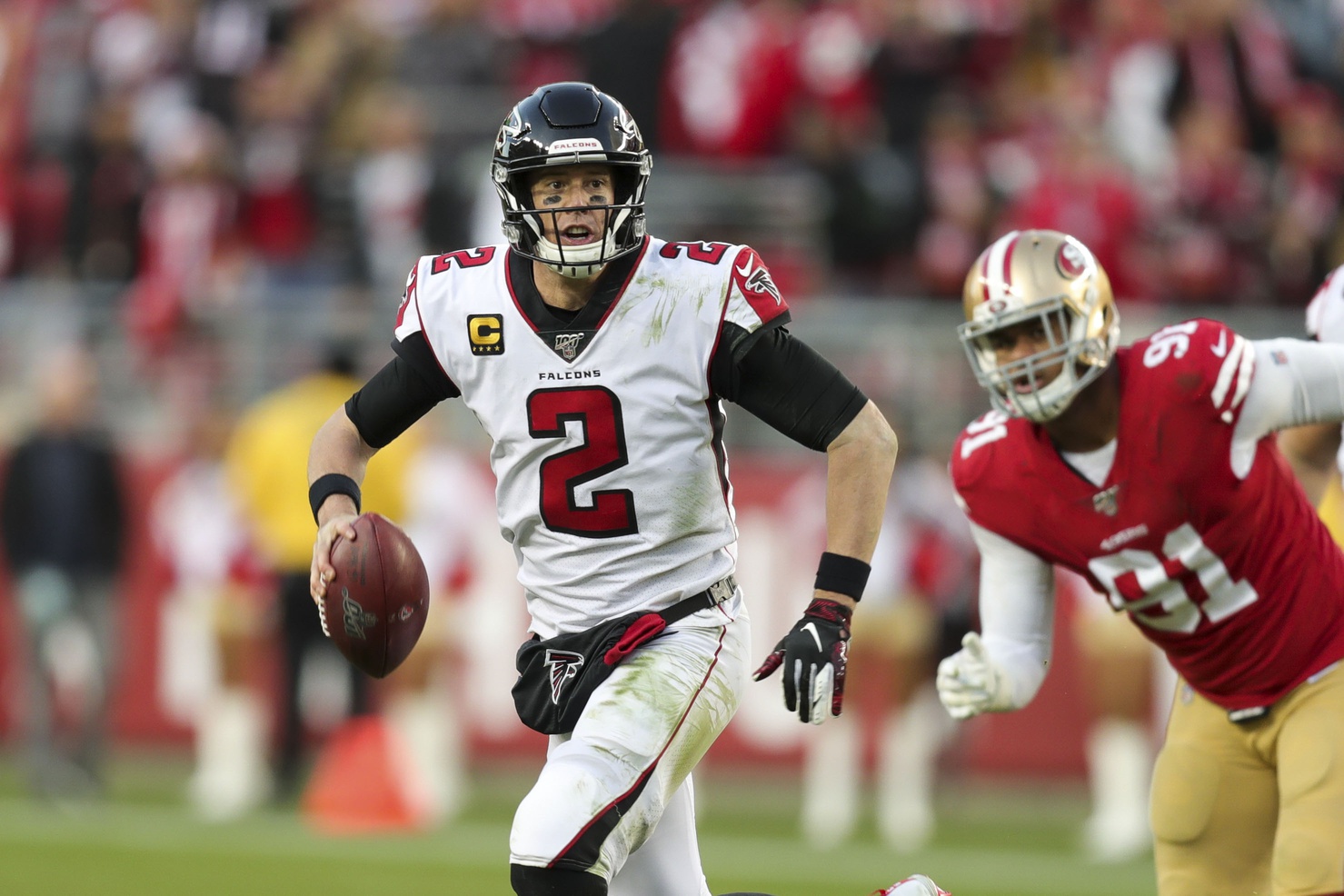
15. Matt Ryan, Atlanta Falcons
Ryan appeared primed to have a big year with a favorable schedule and strong group of playmakers, but his offensive line struggled in pass protection, and he faced his highest pressure rate since 2013 — and that was also the last year that Ryan finished outside of the top 10 in PFF’s quarterback rankings. Ryan finished with his lowest overall grade since 2009, as his season was marred by uncharacteristic poor decisions and a high number of avoidable sacks, even with the increased pressure rate. Despite all of that, Ryan was still one of the best passers from a clean pocket, and he hit open throws at a high rate — both good indicators that even the slightest improvement up front should bode well for next season.
Key Stat from QB Annual: Ryan had the 13th-highest percentage of positively graded throws but also the ninth-highest percentage of negatives.
16. Carson Wentz, Philadelphia Eagles
It was an odd season for Wentz, who was playing better than the stats showed during the first few weeks of the season before ranking near the bottom of the league in PFF grade over the second half of the season. He did have to deal with an incredible number of injuries to his supporting cast, and the end of the season saw multiple gutsy performances when throwing to a different group of receivers seemingly every week. On the positive side, Wentz was among the league’s best in big-time throws, and he was excellent when playing under pressure and outside of structure, though those are all facets that are difficult to duplicate moving forward. On the other hand, Wentz was mediocre in stable situations and below average at hitting open throws, but surrounding him with a full season of good playmakers should get him back on track.
Key Stat from QB Annual: Wentz ranked below average in accuracy to all levels of the field other than 20-plus yard throws, where he was 2.5 percentage points above the league average.
17. Philip Rivers, Los Angeles Chargers
After back-to-back seasons with a top-10 PFF grade, Rivers settled back in with the middle tier of quarterbacks in 2019. As with any older quarterback, questions have been raised about whether Rivers still has it, but he’s been working with diminished tools for a few years now while still finding a way to succeed. The concern is Rivers once again ranking among the league leaders in turnover-worthy plays while experiencing the fifth-highest increase in total negatively graded throws this season. That volatile style is not new for Rivers, as he still ranked among the best in big-time throws while showing his usual anticipation when throwing to all levels of the field. Rivers has been playing behind terrible pass blocking for a few years now, but he’s shown that he can still produce, especially if given a few more clean pockets to work from moving forward.
Key Stat from QB Annual: Rivers ranked 14th in big-time throw percentage but just 32nd at avoiding turnover-worthy plays.
18. Baker Mayfield, Cleveland Browns
After one of the best rookie seasons of the last 10 years, Mayfield had a disappointing 2019 as he regressed in key areas, and some of his college weaknesses crept back into his play. The Browns’ passing attack was never in sync, and while Mayfield had his fair share of poor decisions, he also had an incredible string of unlucky interceptions (passes that are intercepted less than 3% of the time). Among the concerns was Mayfield’s pocket presence, as he invited pressure and vacated clean pockets much more than what we saw as a rookie. Both in college and in the NFL, Mayfield has shown the ability to throw on time and accurately to all levels of the field, and it would not be a surprise to see him return to form despite his setback this season.
Key Stat from QB Annual: Mayfield ranked average or below average in accuracy to all levels except on 20-plus yard throws, where he finished 8.2% percentage points above the league average.
19. Jared Goff, Los Angeles Rams
After three straight years of continued development, Goff took a step back in 2019 to rank among the middle tier of quarterbacks, which coincided with his offensive line's regression in pass protection. He left too many throws on the table, missing a higher percentage than he did in 2018 while ranking in the bottom half at avoiding turnover-worthy plays. The scheme plays also took a hit, as Goff saw the third-largest decrease in positively graded throws, all leading to his uneven season that only really got going in spurts and featured six games with PFF grades of 60.0 or below. As he heads into Year 5, it’s fair to place Goff among the middle class of the league’s signal-callers, a group that is capable of high-end seasons with good play-calling and a strong supporting cast, but also capable of nondescript seasons like Goff had in 2019.
Key Stat from QB Annual: Goff ranked just 23rd in PFF grade from a clean pocket and 14th in PFF grade under pressure.
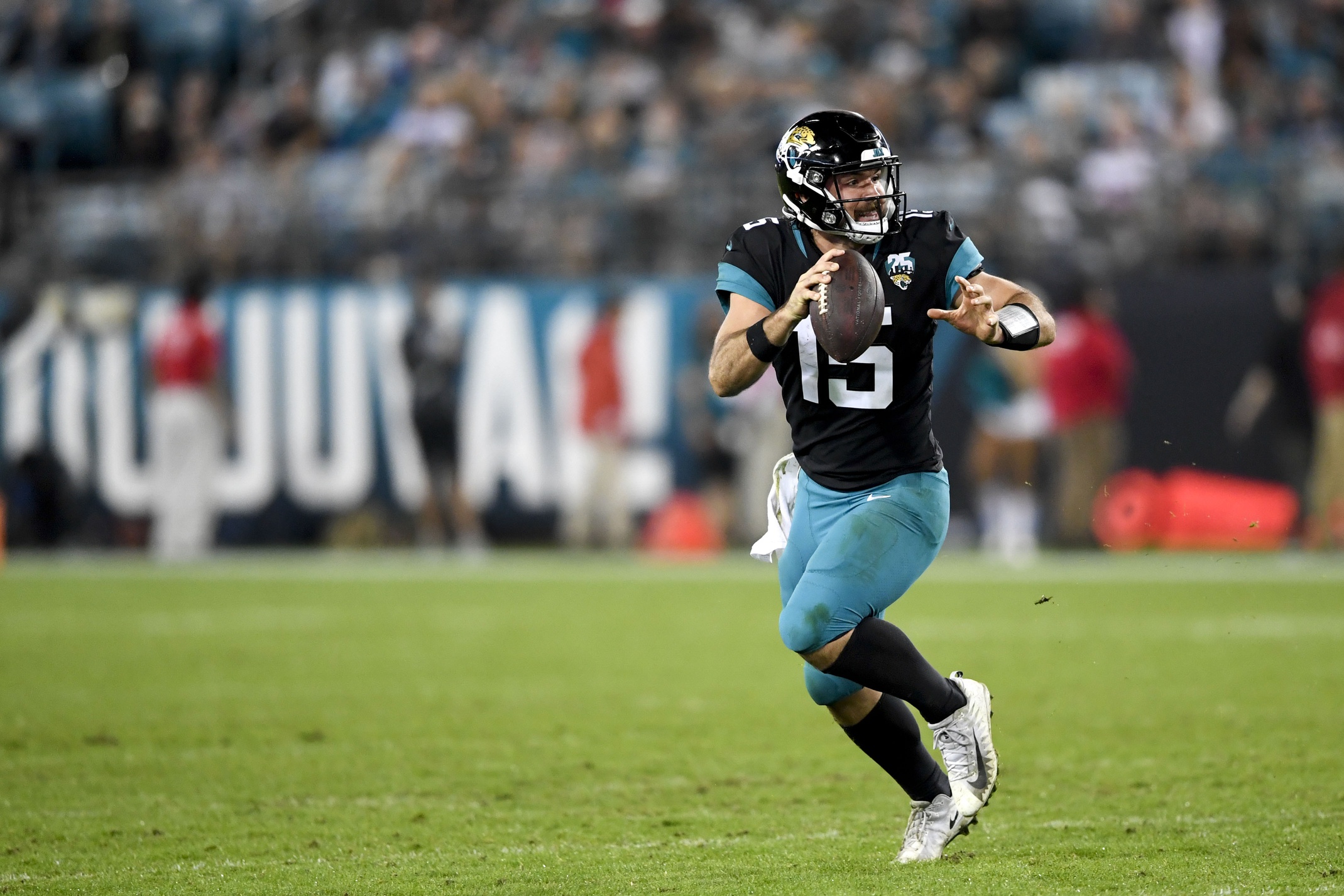
20. Gardner Minshew, Jacksonville Jaguars
Minshew was thrust into the lineup in the first half of Week 1, and he certainly exceeded expectations for a rookie sixth-round pick. Despite his mediocre arm strength, Minshew was excellent throwing the ball down the field, generating the No. 3 PFF grade on 20-plus yard throws. He did a fine job of making the most out of Jacksonville’s offense, which came into the season with few household names in the passing game. Among the negatives, Minshew picked up 38% of his turnover-worthy plays on fumbles, often spending too much time trying to create late in the down. Overall, it was a mid-tier performance for Minshew, who did show starting ability, but there’s plenty to clean up if he’s going to be considered a long-term answer.
Key Stat from QB Annual: Minshew averaged -0.07 EPA per dropback on the scramble drill, below the league average of 0.04.
21. Jameis Winston, Tampa Bay Buccaneers
There’s never been a dull moment in Winston’s career, and his throw-for-throw inconsistency has led to a surprisingly consistent career in which he’s landed between 68.4 and 73.7 in overall PFF grade in every season. The path is never a smooth one, as Winston annually ranks among the league leaders in positively graded throws, but he’s also right there near the top in turnover-worthy play percentage. Even if Winston never cuts down on the negative plays, his aggressiveness creates big-play opportunities in the passing game, and in any given year, a couple of lucky bounces on the bad decisions could lead to top-10 caliber production. It’s a big “if,” but it’s also a worthwhile roll of the dice in a situation with top playmakers and a strong pass defense.
Key Stat from QB Annual: Winston finished third in percentage of positively graded throws but just 32nd at avoiding negatives.
22. Joe Flacco, Denver Broncos
The Broncos were hoping for a Flacco rejuvenation in a new environment, but it was more of what we’ve seen in recent years. Flacco threw the ball accurately, but he did most of his work underneath and rarely attacked downfield. With a low percentage of positives and a low percentage of negatives, Flacco has settled in as a more conservative game manager type, though that’s offset by poor pocket presence that led to too many sacks and fumbles. While Flacco may never be the aggressive downfield thrower of his early years, he still throws the ball well enough at the short and intermediate range, and if he can speed up the internal clock, there may be another useful season or two in there in the right situation.
Key Stat from QB Annual: Flacco’s EPA per dropback steadily declined the longer the play went, and he was most productive on passes up to 2.6 seconds (0.05 EPA per pass play).
23. Andy Dalton, Cincinnati Bengals
We’ve seen strong production from Dalton when he’s given a good group of playmakers and offensive linemen, but it was a rough 2019 season with one of the league’s worst supporting casts. Dalton posted his lowest PFF grade since 2012 and the worst statistical output since his rookie year in 2011. He regressed in many key areas, including the fourth-highest increase in negatively graded throws. Dalton is still capable of producing in the right situation, and perhaps Ryan Tannehill's breakout will lead to a team trying to duplicate that magic. Dalton hits open throws at a high rate and ranked near the top in accurate-plus (perfect) passes, but he’s consistently graded between 62.0 and 73.0 in all but three of his nine years, so you should know what you’re getting at this point in his career.
Key Stat from QB Annual: Dalton ranked just 34th at throwing catchable passes, but he also ranked fourth in percentage of accurate-plus (perfect) throws.
24. Daniel Jones, New York Giants
There was plenty to like from Daniel Jones' rookie season — he attacked effectively down the field and had multiple high-end games from a production standpoint. The big question is the turnover-worthy plays, as he put the ball in harm’s way at a high rate, both as a passer and in the pocket with too many poor fumbles. Jones is fearless under pressure, which leads to big-time throws, but he also had numerous forced throws and a league-high 10 fumbles that were deemed turnover-worthy. With this playing style, the range of outcomes is wide, meaning Jones may have high-end seasons with a strong supporting cast and some luck, or it could go the other way in a hurry. Still, Jones did a good job of avoiding the overall negatives, and his downfield aggressiveness could lead to big seasons in New York.
Key Stat from QB Annual: Jones had above-average accuracy on tight-window throws, but he ranked below average when receivers were open by a step or more.

25. Kyler Murray, Arizona Cardinals
There was a point in Murray’s season in which it looked like a perfect, natural progression for a rookie with superstardom was right around the corner. He started off with some rookie mistakes before hitting a hot streak, and a strong finish would have had Murray primed for a second-year breakout that has become commonplace around the NFL. Unfortunately, he put together the two worst games of his season in Weeks 13 and 14, perhaps taking some of the luster away from an otherwise solid rookie campaign. Regardless, Murray showed off the velocity and touch to create plays down the field, and, when combined with his dynamic running ability, he has game-changing big-play ability moving forward. That scrambling ability also leads to Murray taking too many sacks, many of which were his own doing and not the fault of poor blocking. He must find the proper balance and cut back on the negative plays.
Key Stat from QB Annual: Murray ranked eighth in overall accuracy percentage, but he came in below average on passes thrown at 10-plus yards down the field.
26. Josh Allen, Buffalo Bills
Allen made strides in key areas, as he graded among the league’s best on passes up to 19 yards downfield, but he still had issues with 20-plus yard throws and avoiding turnover-worthy plays. The Bills did a fine job of passing on early downs and finding short-area playmakers to get open for Allen, and that led to his improved completion percentage. The deep ball was an issue for Allen, though, and he had the highest percentage of uncatchable passes on 20-plus yard throws. And even though he cut down on his interceptions, Allen was still among the league’s worst in turnover-worthy play rate, in large part due to fumbles. The good news for Allen is that the short and intermediate passing game is more stable from year to year, while deep passing is often wide-receiver dependent, so the 2019 season was a step in the right direction in his development.
Key Stat from QB Annual: Allen finished 11th in percentage of positively graded throws but 35th at avoiding negatives.
27. Mitchell Trubisky, Chicago Bears
There wasn’t too much of a difference between Trubisky’s 2018 and 2019 seasons on a throw-for-throw basis, but he received far more help from playmakers and had better overall luck in 2018. In 2019, he missed too many passes, ranking among the league’s worst in negatively graded throws, and he ranks in the bottom third in catchable-pass rate. Trubisky was a weapon with his legs in 2018, but that regressed this past year as he took off on fewer scrambles. While Trubisky played his best football during the second half of the season, he still finished the year with eight games of sub-60.0 PFF grades (after seven such games in 2018), and there are still many question marks to his game as we head into his fourth year in the league.
Key Stat from QB Annual: Trubisky’s accuracy was at least average at all levels of the field except the intermediate (10-19-yard) range where he was 12.1 percentage points below the league average.
28. Sam Darnold, New York Jets
Darnold’s career has been a roller coaster ride to this point, as he started slow and finished strong as a rookie before putting together a similar stretch of good and bad play in 2019. He missed time due to mononucleosis before a disastrous performance on Monday Night Football against the Patriots. Darnold followed up with a midseason improvement before a mediocre stretch of play to finish the season. On the positive end, Darnold did return to his college form, showing good accuracy in the short game, but he ranked near the bottom on 10-plus yard throws. Those numbers should improve with a better group of playmakers in the coming years.
Key Stat from QB Annual: Darnold’s accuracy was above average up to 20 yards, but he finished 10 percentage points below the league average on 20-plus yard throws.
29. Jacoby Brissett, Indianapolis Colts
The season got off to a great start for Brissett statistically, but his PFF grade didn’t match the production, as he had some turnover luck and excellent work after the catch from his playmakers. Production and on-field performance merged as the season progressed, and Brissett finished the season among the lowest-ranked quarterbacks in the league. Brissett has played more of a game manager role, ranking near the bottom in both overall positives and big-time throws while also avoiding turnover-worthy plays. We now have two full seasons of grading for Brissett, and he’s ranked in the bottom third of quarterbacks in both years, raising fair questions about his long-term viability as a starter.
Key Stat from QB Annual: Brissett posted just three game grades of 70.0-plus during the 2019 season.
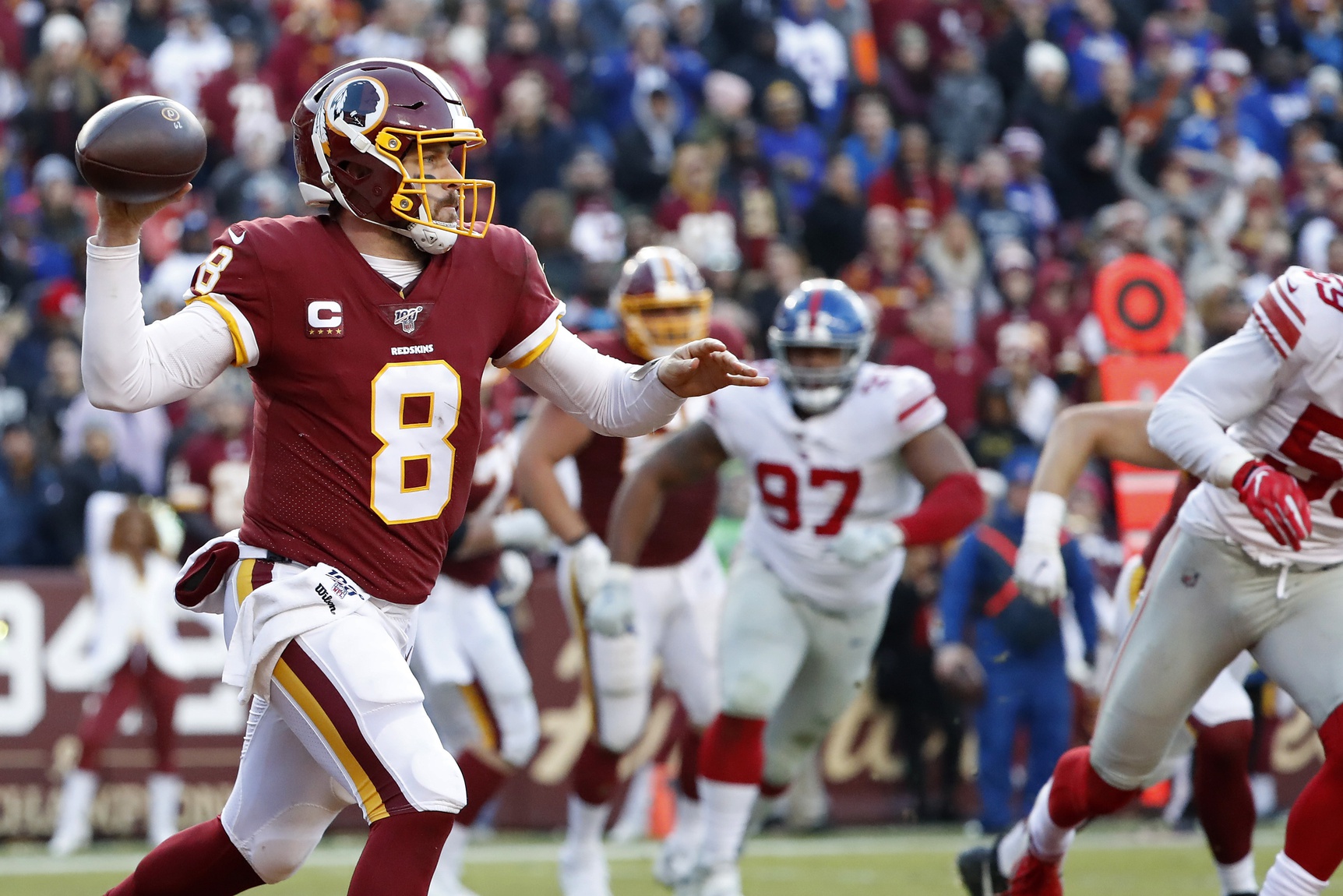
30. Case Keenum, Washington Redskins
Keenum kicked off the season as the starter in Washington, and the first few weeks saw him looking much better statistically than his grades would show. That evened out in a Monday night game against the Bears, and it was only a matter of time before Dwayne Haskins took over as the starter. At this point in his career, Keenum has settled in as one of the best backups in the league and a perfect bridge quarterback. His career year in 2017 still stands out as an outlier, and 2019 Keenum finished among the worst in the league in negatively graded throws and uncatchable passes — two areas in which he must improve if he’s going to get another starting opportunity.
Key Stat from QB Annual: Keenum averaged -0.057 EPA per dropback when pressured, well below the league average of -0.042. In his career season in 2017, he averaged an unsustainable -0.09 EPA per pressured dropback.
31. Mason Rudolph, Pittsburgh Steelers
Rudolph was the first to take over once Ben Roethlisberger went down for the season, and he struggled in several key areas. Rudolph’s downfield passing ability made him an intriguing prospect at Oklahoma State, but he finished with the lowest grade in the league on 10-plus yard throws. Rudolph had a few solid games, but overall, a lack of big-time throws, too many turnover-worthy plays and an inability to throw accurately down the field marred the first extended action of his career.
Key Stat from QB Annual: Rudolph averaged just -0.39 EPA per dropback when getting to his second (next) read, well below the league average of -0.05.
32. Kyle Allen, Carolina Panthers
Allen took over for an injured Cam Newton in Week 3, and he turned heads with a PFF Team of the Week performance that was littered with big-time throws. But he never reached those heights again, and even though he had an impressive stat line after four starts, the PFF grade told a story of turnover luck going his way. Things evened out as the season progressed, and Allen finished with the highest rate of turnover-worthy plays in the league. So, while he showed off the big-time throws that made him a top recruit, he must do a better job of taking care of the ball if there’s another starting opportunity. Overall, it was an encouraging season for an unknown, undrafted player, but Allen has plenty to improve on after ranking among the league’s worst in the most key, stable metrics.
Key Stat from QB Annual: Allen showed above-average accuracy on all passes in the short to intermediate range.
< 250 dropbacks
Teddy Bridgewater, New Orleans Saints
Bridgewater saw his first extended action since 2015, and he made the most of it. His skill set remains one that is most similar to the safe, game manager quarterback types, as he finished among the league’s best at avoiding negatives and turnover-worthy plays while also posting a low percentage of positives. On the concerning end, Bridgewater’s stats were aided by the scheme and playmakers in New Orleans, and he graded below average in a number of key, stable metrics. Bridgewater’s performance matches what we saw in his two years as a starter in 2014 and 2015 for the Vikings, and it’s fair to project that game manager style if he gets an opportunity to start in 2020.
Key Stat from QB Annual: Bridgewater had just the No. 25 PFF grade when playing in a clean pocket, but he ranked ninth when facing pressure.
Dwayne Haskins, Washington Redskins
Haskins had his ups and downs as a rookie, making plays outside of structure but also struggling in key situations from the pocket. He did a nice job of taking care of the ball, ranking among the league leaders in avoiding turnover-worthy plays, and he was on the wrong end of some bad luck on multiple interceptions. Haskins must improve pocket presence, though, as he took too many sacks — many of which could have been avoided. While he performed better than expected on plays outside the pocket, Haskins will take the next step when he cleans up his work in more classic dropback situations. Overall, he missed a high percentage of throws while inviting pressure more than you’d like to see. He must get back to the efficient short and intermediate thrower that he showcased at Ohio State.
Key Stat from QB Annual: Haskins had the fifth-lowest percentage of turnover-worthy plays, but he ranked 31st at avoiding all negatives.
Drew Lock, Denver Broncos
After a preseason in which Lock looked out of sync in his first NFL action, it was good to see him much more comfortable once he was handed the reins down the stretch. It was a small sample size, but Lock threw the ball well up to 10 yards while doing a nice job of avoiding negatively graded throws. But even with the Broncos going 4-1 with Lock, he had some help. Altogether, 53.3% of his yards came after the catch, the seventh-highest rate in the league, and he graded last among signal-callers on 10-plus yard throws. Lock flashed the arm that made him a coveted prospect last draft season, but he still has plenty to prove. Most importantly, Lock’s comfort level was much better than what he showed in the preseason — and he has a history of improvement, as he increased his PFF grade in all four years at Missouri.
Key Stat from QB Annual: Lock finished with above-average accuracy up to nine yards, but he was below average on passes thrown at 10-plus yards.
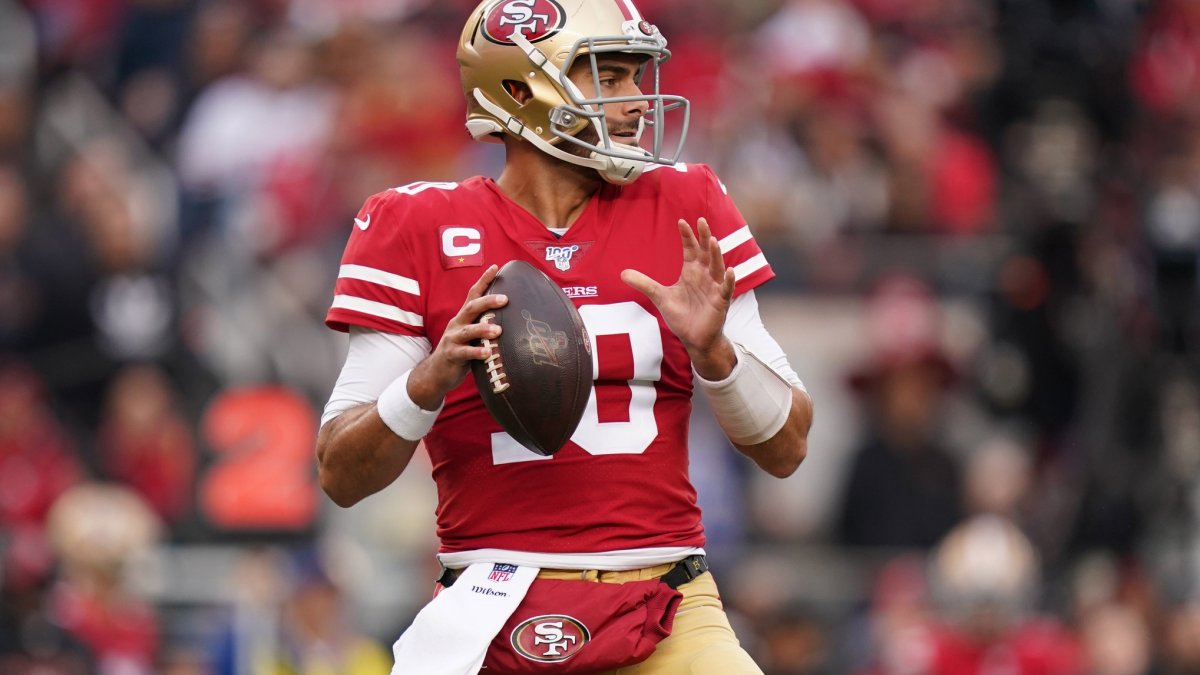


 © 2025 PFF - all rights reserved.
© 2025 PFF - all rights reserved.